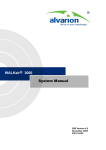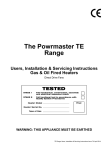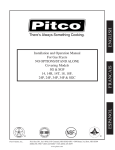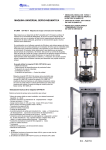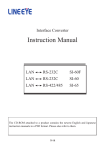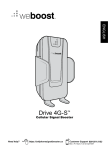Download User manual
Transcript
Stealth X2 Dual Band Boosters BUILDINGS HOMES COTTAGES ® Stealth X2 Dual Band Boosters Table of Contents Features ......................................................................3 Specifications .............................................................3 Package contents ...................................................4 Optional Parts ............................................................4 Antenna and Booster Installation .....................5 Installation Illustrations .........................................6 Control panel ...........................................................7 LED lights - Outside signal level/RX power .....7 Gain level ..................................................................8 Manual gain control ..............................................8 LED lights - Gain level ...............................................9 Tech support .............................................................9 Frequently asked questions .............................10 Troubleshooting guide ......................................10 Inside Antennas .....................................................11 Outside Antennas ................................................11 Extention Cables ....................................................12 Splitters/Power Dividers ......................................12 Specifications .........................................................13 Glossary of terms .................................................14 FCC information ....................................................14 Warranty ..................................................................14 Pg. 2 ® Features Pwr ON/OFF Switch & LED Receive Signal Power Level (Orange LED) Gain Level Indicator (LED) Master Control Switch Control Buttons for: Manual Gain - 2dB steps & LED Brightness Level This is a CONSUMER device BEFORE USE, you MUST REGISTER THIS DEVICE with your wireless provider and have your provider’s consent. Most wireless providers consent to the use of signal boosters. Some providers may not consent to the use of this device on their network. If you are unsure, contact your provider. You MUST operate this device with approved antennas and cables as specified by the manufacturer. Antennas MUST be installed at least 20 cm (8 inches) from any person. You MUST cease operating this device immediately if requested by the FCC or a licensed wireless service provider. WARNING. E911 locator information may not be provided or may be inaccurate forcalls served by using this device. To comply with FCC rules the use of this device in any building is for personal use only. Pg. 3 Package Contents NOTE: Antennas and cables may be different than shown depending on your kit configuration Booster Outside Antenna Inside Antenna Power Supply Extension Cable Optional Parts Co-Ax Cables Omni Directional Antennas Pg. 4 Antenna Pole Mount Kit RF Splitter/Power Divider Co-Ax Adapters Antenna and Booster Installation Donor Antenna: (outdoor signal antenna) a) Location: There are three choices. fig. 2, 3, 4. The choice of donor antenna location depends on the signal strength at the donor antenna location. Use your phone to determine if signal at your chosen location is adequate. Better signal level at the donor antenna location equals larger indoor coverage area. b) Directional Donor Antenna: if using a directional donor antenna supplied in the kit (Part# SEMD1), point the antenna toward the desired tower. If the location of the desired tower is not known, initiate a phone call and use the signal indicator on your phone after the booster is operational, while turning the donor antenna, to determine optimum donor antenna direction for maximum signal strength. c) Omni-directional Donor Antenna: if using an omni-directional donor antenna, it is recommended that it is placed as far as possible from the inside antenna, usually, ‘outside pole mount’ is recommended (Fig. 3). Use of omni-directional antennas will require substantial separation distance compared to directional antennas. Fig. 1 Distribution Antenna: (indoor signal antenna) a) Location: There are three choices. fig. 2, 3, 4. The choice of donor antenna location depends on the area to be covered. b) Directional Distribution Antenna: it is recommended that directional antennas are oriented in a fashion that is back to back of each other Fig. 1 c) Omni-directional Distribution Antenna: it is important that omni-directional antennas are separated as far apart as possible from each other. Use of omni-directional antennas will require substantial separation distance compared to directional antennas. Fig. 1 d) Splitting Indoor Signal: it is possible to use more than one indoor antenna to cover areas that are separated by walls or floors by using antenna splitters or power dividers, however splitters have a level of signal loss (3dB) and the added cable run will also have signal loss, therefore the coverage area will be diminished. As a general rule, if outside signal is good, splitting signal to more than one distribution antenna results in reasonable coverage. If outside signal is poor or marginal, splitting signal to more than one distribution antenna results in decreased coverage for both distribution antennas. Use only genuine SmoothTalker splitters. Contact your dealer or www.smoothtalker.com Amplifier/Booster Location: Install the repeater in a location that has proper ventilation, away from excessive heat and moisture. WARNING: Make sure all cables have a good connection and are connected to the corresponding antenna port on the Booster. DO NOT APPLY POWER or turn on the power switch on the Amplifier/Booster before all cables and antennas are connected. Connection and Start Procedure: Antenna connections must be snug and hand tight, ‘Do Not Use Pliers or Wrench’. Connect the cable from outdoor antenna to RF port (antenna connector) labeled “Outdoor Antenna”. Connect cable from indoor antenna to RF port labeled “Indoor Antenna”. Connect supplied AC/DC power supply to the amplifier and plug it into power source. Turn on the power switch on the Amplifier/Booster. Pg. 6 Pg. 5 Fig. 1 Directional antennas separation distance - Close Omni directional antennas separation distance - Far Distribution Antenna (pointed indoors) Booster Donor Antenna (pointed outdoors) Fig. 2 Fig. 3 Pg. 6 Fig. 4 Pg. 7 Control Panel: Understanding the Control Panel and LED lights General: Mobile networks, phones and data devices operate in two frequency bands (800Mhz & 1900Mhz). The Stealth Booster will amplify signals in both bands if they are present. The band that the phone or cellular data device will transmit (TX) and receive (RX) on is determined by the cellular provider and cannot be chosen by the user. The booster LED lights will indicate outside signal level and booster gain. The ‘Master Control’ button on the control panel will allow the user the option to increase gain, decrease gain or shut off one or both of the frequency bands. Receive Signal Power Level (Orange LED) Gain Level (Green LED) Master Control Switch Control Buttons for: Manual Gain - 2dB steps LED Light Brightness: the user can control the LED brightness of all LED lights by pushing the up or down arrows on the control panel. Receive Signal Power Level LED lights: three orange LED lights for each frequency band receive signal (RX) power being amplified by the booster and transmitted into the building. This indicator is affected by two things : the outside signal and attenuation that is applied by the user or the automatic controls of the booster. The highest level signal being displayed by the booster lights can belong to any service provider, not necessarily your service provider. Note: if attenuation (gain reduction) has been applied by the automatic controls of the booster or by the user, you may see low signal indication on the booster LED lights even though the true outside signal is strong. Outside Signal Level/RX Power LED Indicator Light States Outside Signal Level LED Pg. 8 LED1 LED2 LED3 Flashing RX Power 3 Lights Solid ON No Excellent 2 Lights Solid ON, 3rd Light Flashing Yes Good 2 Lights Solid ON, 3rd Light OFF No Fair 1 Light Solid ON, 2nd Light Flashing Yes Fair to Low 1 Light Solid ON, 2nd & 3rd Lights OFF No Low 1 Light Flashing, 2nd & 3rd Lights OFF Yes Very Low Pg. 7 Gain Level: Understanding the Control Panel and LED lights General: Four green LED lights for each frequency band will indicate the level of amplification that is being applied by the Booster to the receive (RX) signal and transmit (TX) signal. Gain is applied to both RX and TX signals. Normally all four green LED will be solid on. If any green LED lights are flashing or off, it is an indication that gain has been reduced. There are four events that will cause the green LED lights to turn off or flash. 1) Shutdown: a) Automatic shutdown will occur in one band or both bands if antennas are placed too close to each other and the ‘Automatic Oscillation (feedback) Suppression’ function cannot eliminate the oscillation. TX and RX gain will be turned off completely in the frequency band where oscillation cannot be suppressed. b) Manual shutdown can also be achieved in one or both frequency bands by the user. 2) Oscillation (feedback) Suppression: The booster will automatically apply attenuation (reduce gain) to suppress oscillation (feedback). This function is automatic and cannot be manually overridden. 3) RX High Power Control: The booster will automatically apply attenuation (reduce gain) if RX power is too high. This function is automatic and cannot be manually overridden. 4) Manual Attenuation: Gain can be increased or decreased manually by the user in 1dB steps over a range of 35 dB for each frequency band, however, the user will not be able to reduce attenuation that has been applied by the automatic oscillation suppression function or by the automatic high power control function in order to protect both, the cellular tower and the booster. Manual Gain Control The master control button has 3 functions which cycle every 3 times pressed as follows: 1) 800mhz manual gain control Press once. The 3 orange LED lights for the 800 mhz band will flash together. Use up or down arrows to adjust gain in this frequency band as desired. Each push of the up or down button will adjust 1 dB of gain. Total manual adjustment range is 35 dB. Adding more than 35 dB of attenuation will shut down the frequency band. Quick shutdown of the frequency band can also be achieved by holding the down arrow. When the frequency band shuts off all of the orange and green LED lights for that frequency band will flash every 2 seconds. 2) 1900mhz manual gain control Press second time. The 3 orange LED lights for the 1900 mhz band will flash together. Use up or down arrows to adjust gain in this frequency band if desired. Each push of the up or down button will adjust 1 dB of gain. Total manual adjustment range is 35 dB. Adding more than 35 dB of attenuation will shut down the frequency band. Quick shutdown of the frequency band can also be achieved by holding the down arrow. When the frequency band shuts off all of the orange and green LED lights for that frequency band will flash every 2 seconds. 3) Manual gain LED display Press third time to display the LED status of your inputed manual gain settings then power the booster OFF/ON for manual settings to take effect. Each time you cycle to this 3rd setting you will see your inputed manual gain settings displayed on the LEDs. Note: the booster will remember manual settings through power on and off conditions. If you want to return the booster to ‘Fully Automatic Mode’ you must push and hold the master control button (approximately 3 to 5 seconds) until you see all 800mhz lights flash once from left to right followed by 900mhz lights flash once from left to right. Power the booster OFF and then ON for ‘fully automatic mode’ to take effect. Important: a) for manual settings to take effect, the booster must be powered OFF and then ON. b) manual settings cannot override the automatic functions of oscillation and high power controls. This means that if you are trying to set a gain level higher than the automatic control functions allow, the manual gain settings will be limited by the automatic control functions. Pg. 8 Pg. 9 Gain Level LED Indicator Light States There are four green LED lights for each freq. band (800Mhz & 1900Mhz). Each LED represents 10dB of attenuation that is displayed as 1 to 4 flashes and solid ON. Gain Level LED Status LED1 LED2 LED3 LED4 Flashing Pattern Attenuation (gain reduction) 4 Lights Solid ON None 0 dB 3 Lights Solid ON, 4th Light Flashing 4 Times 3 Times 2 Times 1 Times 2 dB 4 dB 6 dB 8 dB 3 Lights Solid ON, 4th Light OFF None 10 dB 2 Lights Solid ON, 3th Light Flashing 4 Times 3 Times 2 Times 1 Times 12 dB 14 dB 16 dB 18 dB 2 Lights Solid ON, 3rd & 4th Light OFF None 20 dB 1 Light Solid ON, 2nd Light Flashing 4 Times 3 Times 2 Times 1 Times 22 dB 24 dB 26 dB 28 dB 1 Light Solid ON None 30 dB More then 35db of attenuation the Freq band will shut down and it’s LED lights will flash together every 2 seconds 800mhz 1900mhz Tech Support: [email protected] Live tech Support: 9:00 am - 6:00 pm EST Mon - Fri Toll free1-877-726-3444 Pg. 10 Pg. 9 Frequently Asked Questions My booster is powered, running and the lights are on but my signal did not improve. Why? Check your antenna connections and make sure they are snug. Also make sure that the external and internal antennas are connected to corresponding antenna ports of the booster. Should the booster get hot? Normal operation temperature for the booster is approximately 109° F, or 43° C. This will feel warm to the touch. Will the booster improve Voice and Data signals? Yes. How large should my inside coverage area be? Coverage area is dependent on two factors; the booster’s gain and the signal level at the outside antenna. It is possible to cover a large area with a low gain booster if the outside signal is excellent, conversely, it is possible to have relatively small coverage area with a high gain booster if the signal outside is really poor. How do I increase my indoor coverage area? If your inside coverage area is inadequate, try to move your external antenna to a location with better signal. If antenna location is optimized the coverage area is still too small, use a higher gain booster. Will the booster boost signals from service providers other than mine? Yes. Smoothtalker Stealth series boosters are wideband RF amplifiers that will improve all Cellular and PCS signals in your area. Why does my friend’s phone show better signal than mine? Your friend’s phone is probably using a different service provider that has a tower closer to your location than your service provider. For best indoor coverage, make sure that your outside antenna is pointing at your service provider’s tower. Can I leave my booster on continuously? Yes. Can I leave my booster on during a lightning storm? To be 100% sure that lighning will not damage the booster, you must unplug it from the wall and disconecct the external antenna from the booster. If you must keep connected during lightning you can use a lightning arrestor on the antenna and high quality surge protector on the power supply, however, Smoothtalker warranty does not cover lightning damage. I need more cable length. What do I use? The only extention cables that are FCC approved for use with this booster are listed on page 13. Troubleshooting Guide Condition Automatic Shutdown. Manual Shutdown. LED indicators Orange and green LED flash simultaneously every 2 secs in the freq. band that has been shutdown. Orange and green LED flash simultaneously every 2 secs in the freq. band that has been shutdown. One or more green LED solid ON, one green LED flashing or OFF. Oscillation (feedback) Suppression: Automatic cannot be manually overridden. High power control due to One or more green LED solid ON, one High RX signal (signal from green LED flashing or OFF. tower): Automatic cannot be manually overridden. Manual Attenuation. One or more green LED solid ON, one green LED flashing or OFF. Pg. 10 Action Separate antennas and/or re-orient directional antennas (back to back) and power OFF/ON the booster. Use control panel to increase gain to the desired level in the chosen freq. band and power OFF/ON the booster. Gain has been reduced to suppress oscillation (feedback). Separate antennas and/or re-orient directional antennas (back to back) and power OFF/ON the booster. Gain has been reduced to suppress high RX signal: a) Directional donor (outside) antenna: turn to point away from tower. b) Omni antenna: change to a location with lower signal. Use control panel to increase or decrease gain to the desired level in the chosen freq. band and power ON/OFF the booster to set. Pg. 11 FCC Rules specify that all approved antennas, cables and accessories to be used with this booster are to be listed in this manual. The approved accessories are listed below. Inside Antennas Description Cable Minimum Cable loss (dBi) Maximum Antenna Gain (dBi) Net gain (dBi) SEMD1XL Inside antenna 18 ft. SEMRC205 -2 8.14 6.14 SEMOXL Inside antenna 18 ft. SEMRC205 -2 0 -2.14 SEMOX Inside antenna 10 ft. SEMRC105 -2 0 -2.14 SEMR1 Inside antenna Direct to booster 0 0 2.14 Antenna Part # Outside Antennas Description Cable Minimum Cable loss (dBi) Maximum Antenna Gain (dBi) Net gain (dBi) SEMD1XL Outside antenna 18 ft. SEMRC205 -2 8.14 6.14 SEMDA2XL Outside antenna 18 ft. SEMRC205 -2 9.14 7.14 SEMOXL Outside antenna 18 ft. SEMRC105 -2 0 -2.14 SEM2THX Outside antenna 14 ft. SEMRC105 -1.5 2.14 0.64 SEM11THX Outside antenna 14 ft. SEMRC105 -1.5 5.14 3.64 SEM14THX Outside antenna 14 ft. SEMRC105 -1.5 5.14 3.64 SEM26THX Outside antenna 14 ft. SEMRC105 -1.5 7.14 5.64 SEM2THXL Outside antenna 25 ft. SEMRC105 -2.75 2.14 -0.61 SEM11THXL Outside antenna 25ft. SEMRC105 -2.75 5.14 2.39 SEM14THXL Outside antenna 25 ft. SEMRC105 -2.75 5.14 2.39 SEM26THXL Outside antenna 25 ft. SEMRC105 -2.75 7.14 4.39 Antenna Part # Pg. 11 Extension Cables Cable Part # Description Cable Minimum Cable loss (dB) SEMRCBXmaXfe10 extension cable 10 ft. SEMRC205 -1 SEMRCBXmaXfe20 extension cable 20 ft. SEMRC 205 -2 SEMRCBXmaXfe30 extension cable 30 ft. SEMRC205 -3 SEMRCBXmaXfe40 extension cable 40 ft. SEMRC205 -4 SEMRCBXmaXfe50 extension cable 50 ft. SEMRC205 -5 SEMRCBXmaXfe60 extension cable 60 ft. SEMRC205 -6 SEMRCBLXmaXfe10 extension cable 10 ft. LMR400 -0.6 SEMRCBLXmaXfe20 extension cable 20 ft. LMR400 -1.2 SEMRCBLXmaXfe30 extension cable 30 ft. LMR400 -1.8 SEMRCBLXmaXfe40 extension cable 40 ft. LMR400 -2.4 SEMRCBLXmaXfe50 extension cable 50 ft. LMR400 -3 SEMRCBLXmaXfe60 extension cable 60 ft. LMR400 -3.6 SEMRCBLXmaXfe70 extension cable 70 ft. LMR400 -4.2 SEMRCBLXmaXfe80 extension cable 80 ft. LMR400 -4.8 SEMRCBLXmaXfe90 extension cable 90 ft. LMR400 -5.4 SEMRCBLXmaXfe100 extension cable 100 ft. LMR400 -6 Splitters/Power Dividers Part # Pg. 12 Description Insertion loss (dB) Net gain (dB) ADCSP1 2-way power divider -3 -3 ADCSP3 3-way power divider -3 -3 Specifications Operational Bands 800MHz Cellular and 1900MHz PCS Impedance 50 Ohms TX Output Power 29.9 dBm EIRP RX Output Power 11.0 dBM EIRP Oscillation Control (Automatic) 35 dB in 1db steps Oscillation Control Timing < 1 sec RX High Power Control Dynamic up and down < 50 milliseconds TX High Power Control Dynamic up and down < 50 milliseconds Current Draw @ 12V 0.5 Amp - 0.8 Amp Operating Voltage 6V Noise Figure < 5dB Operating Temperature -32F to +85F Outside Antenna Connector MCT Male Inside Antenna Connector MCT Male Dimensions 6.25x3.5x1.125 inches Weight 1.0 Lb FCC ID S4RBRB81975 Model Maximum Gain BRBX2-72 72dB BRBX2-70 70dB BRBX2-68 68dB BRBX2-65 65dB BRBX2-62 62dB BRBX2-60 60dB BRBX2-58 58dB BRBX2-55 55dB Pg. 13 Glossary of Terms Attenuation: the reduction of the RF signal usually measured in dB. Attenuation is the opposite of Gain. Increasing attenuation has the same effect as turning down the volume control of a radio or stereo speaker. Booster: also known as: RF amplifier, repeater or signal enhancer. dB: short form for decibel. Unit of measure for RF signal gain or attenuation. Directional antenna: an antenna designed to focus its energy mostly in one direction. Distribution antenna: internal antenna used to distribute signal to the interior of a building or structure. Donor Antenna: outside antenna used to provide signal from outside to inside. Frequency band: the operational frequency range of the Smoothalker booster and the cellular network frequencies that are amplified. These are commonly referred to as the ‘Cellular Band’ (824-894 Mhz) and the ‘PCS Band’ (1850-1990 Mhz). Gain: the increase of the RF signal usually measured in dB. Gain is the opposite of Attenuation. Increasing gain has the same effect as turning up the volume control of a radio or stereo speaker. LED: Light Emitting Diode. Omni-directional antenna: an antenna designed to radiate its energy equally in all directions. Oscillation: term to describe a feedback loop. This occurs when the signal from one antenna reaches the other antenna and the booster amplifies the signal creating a loop. This is the same effect as the squeal one hears when a speaker is brought close to a microphone. RF: Radio Frequency. RX: ‘receive signal’ originating at a base station or tower. Splitter/Power Divider: a component with input and output connectors that will allow one originating signal to be split and distributed to two or more antennas. TX: ‘transmit signal’ originating from a cellular phone or data device. FCC Part: §15.21 Information to Users “The users manual or instruction manual for an intentional or unintentional radiator shall caution the user that changes or modifications not expressly approved by the party responsible for compliance could void the user’s authority to operate the equipment. In cases where the manual is provided only in a form other than paper, such as on a computer disk or over the Internet, the information required by this section may be included in the manual in that alternative form, provided the user can reasonably be expected to have the capability to access information in that form.” “This device complies with part 15 of the FCC Rules. Operation is subject to the following two conditions: (1) This device may not cause harmful interference, and (2) this device must accept any interference received, including interference that may cause undesired operation.” RF Exposure Warning Please Note: Antenna should be positioned at least 8”(20cm) from all person/persons as per requirements necessary to comply with the FCC MPE rules. Notes: 1-This booster is not user configurable. User changes are a violation under FCC rules and will void the user’s authority to operate the equipment. 2-User changes changes or modifications will void warranty. Warranty Smoothtalker boosters are warranted against manufacturing defects for a period of two years from the date of purchase. The original bill of sale is required for any warranty claims. For warranty claim contact original dealer or smoothtalker.com














